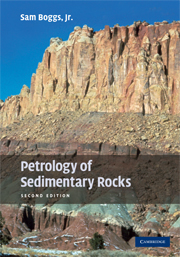Book contents
- Frontmatter
- Contents
- Preface
- Part I Principles
- Part II Siliciclastic sedimentary rocks
- Part III Carbonate sedimentary rocks
- Chapter 9 Limestones
- Chapter 10 Dolomites
- Chapter 11 Diagenesis of carbonate rocks
- Part IV Other chemical/biochemical sedimentary rocks and carbonaceous sedimentary rocks
- References
- Index
- References
Chapter 10 - Dolomites
from Part III - Carbonate sedimentary rocks
Published online by Cambridge University Press: 05 June 2012
- Frontmatter
- Contents
- Preface
- Part I Principles
- Part II Siliciclastic sedimentary rocks
- Part III Carbonate sedimentary rocks
- Chapter 9 Limestones
- Chapter 10 Dolomites
- Chapter 11 Diagenesis of carbonate rocks
- Part IV Other chemical/biochemical sedimentary rocks and carbonaceous sedimentary rocks
- References
- Index
- References
Summary
Introduction
Carbonate rocks range in age from Holocene to Precambrian. The mass of Precambrian carbonate rocks is much smaller than that of Phanerozoic carbonates, which are particularly abundant in stratigraphic sequences of Paleozoic age. Carbonate rocks less than about 100 million years old are dominantly calcium carbonates with a low Mg/Ca ratio consistent with the ratio that would be expected if the rocks formed mainly by accumulation of carbonate skeletal debris. The Mg/Ca ratio rises sharply, but irregularly, with increasing age in carbonate rocks older than about 100 million years. Thus, it has been a commonly accepted tenet that dolomites make up an increasing proportion of carbonate rocks with increasing age and that the average composition of Precambrian carbonate rocks approaches that of the mineral dolomite (Garrels and Mackenzie, 1971, p. 237). This long-accepted view that dolomites increase in abundance relative to other carbonates with increasing age was challenged by Given and Wilkinson (1987). These authors maintain that whereas dolomites do change in relative abundance through time, these changes do not correlate directly with age. Rather, they say that increased amounts of dolomite formation correlate to periods of sea-level highs and continental flooding. In turn, this viewpoint has been challenged by others (e.g. Zenger 1989). Secular variations in dolomite abundance during the Phanerozoic remain a controversial topic; see discussion in Machel (2004).
Whatever the true story of relative abundance, dolomites are an extremely intriguing group of rocks, and they have considerable economic significance as reservoir rocks for petroleum.
- Type
- Chapter
- Information
- Petrology of Sedimentary Rocks , pp. 382 - 407Publisher: Cambridge University PressPrint publication year: 2009



